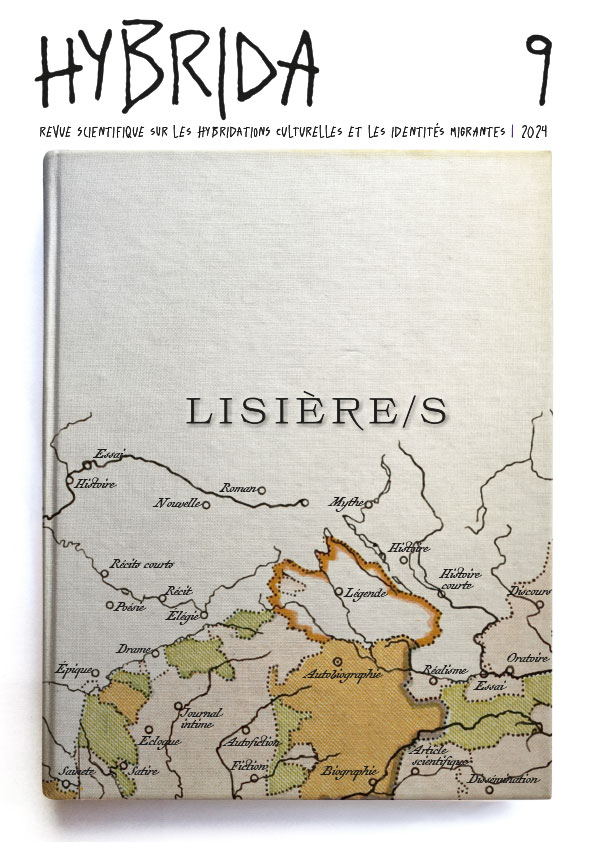The «ecological character» in love in Pauline Delabroy-Allard’s ‘Ça raconte Sarah’ (2018)
DOI:
https://doi.org/10.7203/HYBRIDA.9.29385Keywords:
Pauline Delabroy-Allard, French contemporary literature, ecology and feminism, initiatory novel, lesbianism Abstract
Abstract
In this article, the aim is to analyze the construction of a character in love from an ecological point of view: the homodiegetic and feminine narrator of Pauline Delabroy-Allard’s Ça raconte Sarah published by the Éditions de Minuit in 2018. The notions of «ecological character» (Stéphanie Posthumus), «mesh» (Timothy Morton) and «phenomenological nodes» (Camille Froidevaux-Metterie) are mobilized to propose an ecological and feminist reading on the novel. It presents a passionate love between two women, and more specifically a lesbian initiation (Margot Lachkar), which troubles the identity to the point of transforming the characters’ representations. We then comment on a fantastic modality used to narrate traumatic events when the death of the beloved woman looms. Finally, the influence of fiction and criticism on the readers’ symbolic representations is interrogated.
 Downloads
Downloads
 References
References
Barthes, Roland. (1977). Fragments d’un discours amoureux. Seuil.
Barthes, Roland. (1963). Sur Racine. Seuil.
Berthier, Manon. (2022). Mauvais genres. 1924 ? – 2022, écrire le lesbianisme dans les littératures de l’imaginaire. Dans A. Turbiau, M. Lachkar, C. Islert, M. Berthier et A. Antolin (dir.), Écrire à l’encre violette. Littératures lesbiennes en France de 1900 à nos jours (pp. 171–203). Éditions Le Cavalier Bleu.
Blanc, Jan. (2020). Stilleven : peindre les choses au XVIIe siècle. Éditions 1:1.
Bouguen, Laure et Delabroy-Allard, Pauline. (Hôtes). (24 février 2022). Pauline Delabroy-Allard - « Devenir mère dans un couple homosexuel, le parcours du combatant » (n° 17) [Podcast épisode]. Podcast Ho Kalm. https://hokaran.com/blogs/media/ho-kalm-pauline-delabroy-allard?srsltid=AfmBOopvsUhLyt7J6M9wQVYRcrFFuUuuu0Z-tHXl2RD1I9feW3SVJ9gi
Clément, Jean-Paul. (2007). Chateaubriand et la « fièvre des ruines ». Anabases, (5), 179–189. https://doi.org/10.4000/anabases.3185
Collot, Michel. (2022). Un nouveau sentiment de la nature. José Corti.
Díez Cobo, Rosa María. (2020). Arquitectura del hogar invertido : reescribiendo la casa encantada. Brumal : Revista de Investigación sobre lo Fantástico, 8(1), 135–158. https://doi.org/10.5565/rev/brumal.633
Delabroy-Allard, Pauline. (2018). Ça raconte Sarah. Éditions de Minuit.
Fleury, Cynthia. (2020). Ci-gît l’amer. Guérir du ressentiment. Gallimard.
Froidevaux-Metterie, Camille. (2021). Un corps à soi. Seuil.
Gefen, Alexandre. (2017). Réparer le monde. La littérature française face au XXIe siècle. José Corti.
Haraway, Donna J. (2016). Staying with the trouble : Making Kin in the Chthulucene. Duke University Press. https://doi.org/10.2307/j.ctv11cw25q
Lachkar, Margot. (2022). Portrait d’une littérature en feu. XXIe siècle, écritures bouillonnantes et impatiences politiques. Dans A. Turbiau, M. Lachkar, C. Islert, M. Berthier et A. Antolin (dir.), Écrire à l’encre violette. Littératures lesbiennes en France de 1900 à nos jours (pp. 207–235). Éditions Le Cavalier Bleu.
Loup, Douna. (2021). Les Printemps sauvages. Éditions Zoé.
Mahrer, Rudolf. (2003). Poétique ramuzienne du tableau. Dans D. Jakubec et J. Berney (dir.), Les Signes parmi nous (1919). Dans l’atelier de Ramuz (pp. 265–298). Études de Lettres.
Malick, Terrence. (Directeur). (2011). The Tree of life [Film]. River Road Entertainment/Plan B Entertainment.
Meizoz, Jérôme. (2007). Postures littéraires. Mises en scène modernes de l’auteur. Slatkine.
Morton, Timothy. (2011). The Mesh. Dans S. LeMenager, T. Shewry et K. Hiltner (dir.), Environmental Criticism for the Twenty-First Century (pp. 19-30). Routledge.
NIFFF. (16 septembre 2022). NIFFF 2022 : A conversation with Mariana Enríquez [Archives vidéo]. YouTube. https://www.youtube.com/watch?v=lMs1-nWRJPY&list=PLbnfMhdRACk2qDt3oR4urGa9wfeibOnjB&index=13&t=0s
Platon. (1995). La République VII. Le Livre de Poche.
Posthumus, Stéphanie. (2014). Écocritique et ‘ecocriticism’. Repenser le personnage écologique. Dans S. David et M. Vadeam (dir.), La Pensée écologique et l’espace littéraire. Cahiers Figura, 36 (pp. 15-33).
Rabaté, Dominique. (2005). Introduction. Dans P. Glaudes et D. Rabaté (dir.), Deuil et littérature. Modernités 21. Presses Universitaires de Bordeaux.
Ruffel, Lionel. (2016). Brouhaha. Les Mondes du contemporain. Verdier.
Saint-Amand, Denis et Zbaeren, Mathilde. (2022). Incandescences. Revue critique de fixxion française contemporaine (24), n. p. https://doi.org/10.4000/fixxion.2548
Schaeffer, Jean-Marie. (1999). Pourquoi la fiction ? Seuil.
Schaeffer, Jean-Marie. (2007). La Fin de l’exception humaine. Gallimard.
Semilla Durán, María Angélica. (2018). Fantasmas : el eterno retorno. Lo fantástico y lo político en algunos relatos de Mariana Enríquez. Revell. Revista de Estudos Literários da UEMS, 3(20), 261–277. https://periodicosonline.uems.br/index.php/REV/article/view/3309
Vaillant, Alain. (2002). L’Amour-fiction. Discours amoureux et poétique du roman à l’époque moderne. PUV.
Wittig, Monique. (1969). Les Guérillères. Éditions de Minuit.
Zenetti, Marie-Jeanne. (2021). Théorie, réflexivité et savoirs situés : la question de la scientificité en études littéraires. Dans F. Bujor, M. Coste, C. Paulian, H. Rundgren, A. Turbiau et M.-J. Zenetti (dir.), Situer la théorie : pensées de la littérature et savoirs situés (féminismes, postcolonialismes). Fabula-LhT, (26). https://doi.org/10.58282/lht.2769
Downloads
Published
How to Cite
-
Abstract70
-
PDF (Français )45
Issue
Section
License
Copyright (c) 2024 Alicia Schmid

This work is licensed under a Creative Commons Attribution-NonCommercial-ShareAlike 4.0 International License.
All the documents in the OJS platform are open access and property of their respective authors.
Authors publishing in the journal agree to the following terms:
- Authors keep the rights and guarantee HYBRIDA the right to be the first publication of the document, licensed under a Creative Commons license Attribution-NonCommercial-ShareAlike 4.0 International (CC BY-NC-SA 4.0) that allows others to share the work with an acknowledgement of authorship and publication in the journal.
- Authors are allowed and encouraged to spread their work (once published) through electronic means using personal or institutional websites (institutional open archives, personal websites or professional and academic networks profiles) once the text has been published.

















